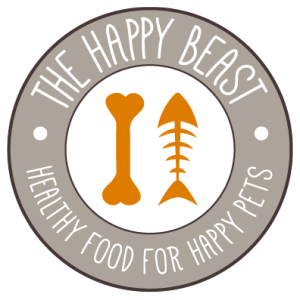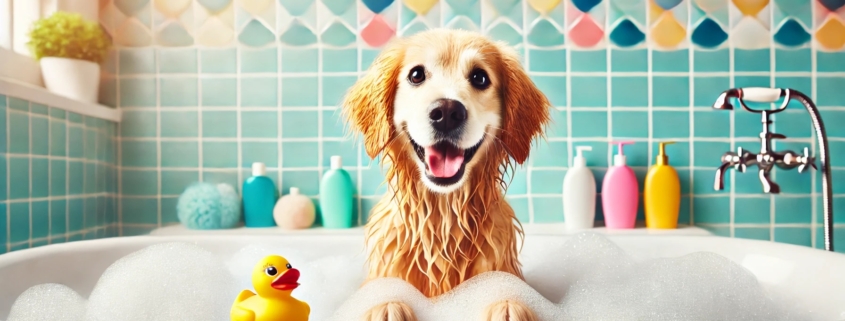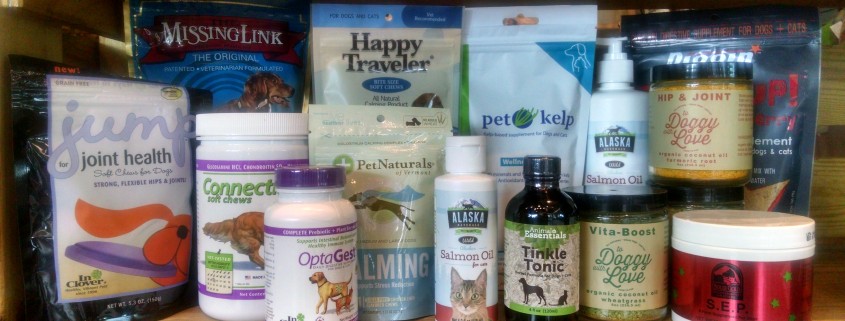Bathing and grooming a dog are important bonding and hygienic experiences for owner and pup. But for some, grooming and bathing our dogs is not always an easy task even for our water-loving friends. In the past, I’ve been lucky enough to work alongside a few wonderful groomers and have bathed countless dogs myself. Here are a few tips and tricks to help get your pup to enjoy a bath (or at least tolerate it)!
Read moreTag Archive for: dog health
Over the last year, and especially ramping up over the last couple of months, we have had a lot of discussions with customers regarding grain-free diets, and concerns about their potential of causing heart disease in dogs – more specifically, canine dilated cardiomyopathy (DCM). We feel it is important to address this topic and review new research with an open mind by looking at all the information and facts available.
Read moreMy dog, Pi, has been prescribed 4-6 weeks of restricted exercise, meaning she has to be kenneled when I’m not home, no running in the yard and walks no longer than 10 minutes. Restricting exercise is often a first line of healing for dogs with soft tissue injuries, but is also prescribed for dogs recovering from surgeries (including spay, neuter, and ACL repair) and broken bones.
For my very active, Aussie-mix, who is accustomed to at least two hours of walking, running and agility practice each day, restricted exercise feels like torture. It’s hard to explain to your animal why you’ve taken their fun and routine away for the sake of healing. So, I’m pulling out old and new resources and looking at this as an opportunity to practice calming exercises and brain games.
Teach and Practice Tricks: Eye Contact, “Ears Up”, “Lick Lips”, and “Leave It”
Pi loves clicker training. If you’ve never tried it, check out this video for the how-to. Clicker training essentially allows you to “capture” a behavior and eventually put it to a command. Eye contact is an easy place to start. Sit in front of your dog and simply click (or say yes!) and treat anytime she makes eye contact with you. For dogs who know how the game works, increase the difficulty by choosing a new behavior to capture. You can click and treat to reward any behavior. We’re working on licking her lips and sneezing.
Practice “Settle”
“Settle” is one of my dog’s favorite games. When she’s healthy the game is actually quite active, beginning in a standing position and running across the room to end lying flat on a mat, repeated over and over. She also gets rewarded for any calm signals when she’s on the mat: shifting her weight to one side, licking her lips, dropping her ears back, resting her chin on the ground. I adapted this game by removing the run and just rewarding the calm signals. Get detailed instructions here.
Beginner’s Scent Work
Canine Nose Work is a sport where dogs learn to identify scents (birch, anise and clove) and search them out in different settings. This problem-solving activity is toted for building confidence and burning mental and physical energy. I adapted this tutorial to teach Pi the basics without requiring her to move around the room.
You’ll need four small boxes, a plastic tub with holes poked in the lid, and smelly, tasty treats.
In the tutorial, your dog waits in another room while you hide the plastic tub in a box. In our adapted version, I’m using only four boxes, because I will be the one moving from the other room to where my dog is.
In a separate room, where your dog can’t see what you’re doing, put a few treats in the plastic tub. Place the tub in one of the boxes, then bring the boxes into your dog’s room and place them on the floor in front of her. Let her smell each one and once she indicates that she’s found the box with treats (for Pi, this was a nose poke to the side of the box) open the tub and let her have her loot! Repeat the game 3-4 times each session and play a few times a day for an excellent brain workout!
As the cannabis industry expands, interest in hemp and marijuana’s health benefits for pets has grown. The cannabis plant is cultivated for both hemp and marijuana harvests and hemp is already a popular material in dog toys, beds and collars. Now even more people are using CBD supplements to improve their pets’ health and well being.
Good to know: CBD vs. THC
CBD (cannabidiol) is derived from marijuana or hemp plants and is touted for its therapeutic effects.
THC (tetrahydrocannabinol) comes solely from marijuana plants and is known for its psychoactive properties.
The CBD used in the supplements and treats we carry at The Happy Beast is extracted from cannabis plants grown to produce hemp and contains less than .3% THC (the psychoactive chemical found in marijuana.) This means: 1) You and your pets will not get “high” from ingesting CBD, and 2) CBD is legal to purchase and possess in all 50 states.
How it works:
All mammals, including dogs, cats, and people have a endocannabinoid system composed of receptors in the brain called CB1s and other receptors in the body called CB2s. Our bodies produce endocannabinoids that bind to these receptors to maintain homeostasis, which means the body stays in balance regardless of environmental changes. A good example of this is how our body temperature stays around 98 degrees even when it’s very hot or very cold in our environment.
Homeostasis becomes more interesting when the body experiences a disruption or injury. We know that pain and inflammation are important in healing, pain lets us know that something is wrong and inflammation initially occurs to protect the body. CBD goes to work on immune and nerve cells to regulate pain and inflammation.
Why supplement with a CBD oil when our bodies already produce endocannabinoids?
First, endocannabinoids are produced by our bodies (“endo” meaning “within”) whereas phytocannabinoids come from the cannabis plant (“phyto” meaning “plant).
New studies show that supplementing with a small daily dose of phytocannabinoids increases the number of CB1 and CB2 receptors which augments the function of the entire system. Some scientists propose that deficiencies in our modern diets decrease the body’s ability to produce a sufficient supply to the point that supplementation becomes necessary.
How to try it:
If you have a healthy dog, PetReleaf treats are perfect for a small daily dose to create balance in the endocannabinoid system.
If your dog or cat is suffering from anxiety, pain, cancer, arthritis, or an otherwise compromised immune system, PetReleaf oil and CannaCompanion capsules provide a concentrated, higher dose of CBD. While CBD has shown no contraindications with other medications or serious side effects, if your animal is under vet care make sure your vet knows you are using it.
And finally, if you’d like more information, just stop by The Happy Beast in Lafayette and we’ll walk you through the various options and benefits.
P.S. Marijuana is STILL not safe for our pets. THC is not the same as CBD, and animals can have adverse reactions to THC, so keep it out of paws reach!
Claire Martin, CCMT (that’s Certified Canine Massage Therapist), CVT, shares advice on taking care of senior dogs and how massage can improve their physical and mental state of health. Check out our event calendar for Claire’s massage days at The Happy Beast and read more about her services at Peak Animal Wellness and Massage.
AGE IS NOT A DISEASE.
“Blessed is the person who has earned the love of an old dog.” – Sydney Jeanne Seward
As my practice continues to grow, over 50% of my patients are animals in their golden years. It is with deep gratitude and honor that I work on these animals, and with some amazing results. While almost any dog can benefit from massage therapy, it’s especially true for senior dogs.
Our dogs grow and age similarly to us. The once overly rambunctious and naughty puppy will eventually begin to slow down. Age is not a disease, and it’s really important to remember to embrace this process with an open mind and an open heart. It can be scary when you suddenly realize you are caring for a senior animal, but use this time to empower yourself with the knowledge and understanding of how to prepare for this inevitable, AND wonderful, experience.
Common Conditions in Older Dogs:
Arthritis – Almost every old dog will experience this, no matter what. It’s just a part of the romping and galavanting that goes on in the puppy years. Would we have it any other way!? My arthritic and senior patients who receive regular massage see MAJOR benefits. The list of massage benefits goes on and on, and soon I’ll have a blog on just that! Adding in Omega fatty acids can be incredibly helpful too!
Dental disease – Dental disease can depend greatly on the breed and size of your pup, but no matter what, it’s really important to address. Dogs are absolutely incredible at hiding pain, and so you may never know this is going on without a thorough oral exam by a veterinarian. Once this is taken care of, your senior dog can munch down — and pain free!
Kidney disease – Pay attention to water intake, change in eating, or bowel habits.
Cancer – Sadly, many of our older dogs suffer from cancer. My best advice, if available, is to create a team for your animal. If there’s an integrative veterinarian near you, this is optimal. Continue feeding your senior pup a high quality diet, and continue letting them do the activities that they love!
Depression – This is a really important piece that I don’t want to skip. Older dogs really can feel a sense of sadness, as they are not physically and mentally able to what they did when they were younger. Massage therapy is a blood-pumping activity that can feel similar to exercise, and can act as a tremendous emotional support as well.
How Can You Help?
Movement – Sometimes we want to protect our senior dogs so much, that we forget that they still need to be dogs! Controlled exercise (multiple, short, leash walks) can be emotionally supportive and also good on overall joint health and flexibility.
Fish Oils – Fish Oils act as a natural anti-inflammatory and help lubricate the joints. If your senior dog (or any dog!) isn’t on these yet, it’s definitely something to consider.
Body Work – Consider massage therapy, for all of the benefits – the physical and emotional benefits, and the detoxifying qualities as well.
Emotional Support – Remember your old pup is still a dog! This is really important for BOTH of you. Be there during the process . . . I know it can be hard.
Here’s the truth:
If you’re really super lucky, your dog will grow old. Every dog and person’s experience will be unique, and it is never easy to lose a best friend. My goal is to keep you feeling prepared and empowered. Let me know what questions you have, or how you are helping your best friend during their golden years.
Love & Light,
Claire
You already have your dog on a healthy diet so what else does your she need for optimal health and wellness? The answer might be dietary supplements.
At The Happy Beast, we always address diet first. A species-appropriate diet lays the foundation for proper health by reducing the risk of illness and injury in animals and helping them recover from existing illness and disease. Often times, our animals have a lifestyle need or health condition that can be addressed by adding supplements to the appropriate diet.
For example, my dog, Pi, eats raw foods prepared by Primal and Small Batch and she occasionally gets air-dried food from The Real Meat Co. She’s on an optimal diet, but to meet her specific health needs, I stock my doggie medicine cabinet with Connectin joint support, a fish oil, Pet Natural’s Calming treats and Optagest prebiotics.
Check out these common scenarios we hear in the store every day and how the right supplement can help improve your animal’s health.
My two-year-old border collie mix is my hiking and running companion.
A young, active dog is susceptible to joint inflammation and injury. Omega-3s from fish oil and glucosamine keep joints healthy and moving. Colorado canines will also benefit from a daily prebiotic or probiotic to stave off environmental bacteria like giardia. Try InClover’s Jump or Connectin for joint health and Optagest Prebiotic and Enzyme.
I have a seven-year-old dog with a history of urinary tract infections and struvite crystals.
Powdered cranberry contains tannins that prevent certain pathogenic strains of bacteria from sticking to the bladder wall. Free-floating bacteria can then pass through the bladder, reducing the risk of infection and growth of struvite crystals. Try Cranimals or Wee Wee Boost.
My lab has itchy dry skin and sheds incessantly.
Omega-3s from fish oil or algae combat inflammation and soothe itchy skin. Anecdotal evidence shows that those same omega-3s reduce shedding, but conclusive research is still ongoing. Try InClover Glow or Alaska Natural’s Salmon Oil.
My dog’s breath stinks!
Bad breath can come from tartar in the mouth or bacteria in the gut. To combat both, pair a prebiotic with a green detoxing supplement. Try InClover’s Grin or PetKelp’s Wellness Blend.
I have a dog who is a Nervous Nelly at the vet and sometimes vomits on car rides.
There are several supplement approaches to calming an anxious dog and some are more effective than others depending on the dog and the cause of anxiety. Theanine helps dogs who are generally anxious, while flower essences like Rescue Remedy work well for sensitive dogs. A dog who vomits in the car will find relief from an herbal supplement like Ark Natural’s Happy Traveler.
My dog got into the trash and she’s had loose stools for the last few days.
Pumpkin fiber soothes tummies by regulating stool volume and density, meaning it binds loose stools and combats constipation. Firm-Up’s dehydrated pumpkin also boasts soluble apple fiber for an extra stomach-soothing boost.
We hope this blog post provides a good, quick summary of some of our favorite supplements, but stop by the store if you’d like to talk more about your pet’s specific conditions and how we might be able to help.
CONTACT US
HOURS
Mon – Fri: 10am – 7pm
Sat: 9am – 6pm
Sun: 10am – 5pm
© The Happy Beast
LOCATION
1230 Etna Dr.
Lafayette, CO 80026
(Get Directions)
Located just off South Boulder Rd. behind Elevations Credit Union and Stan’s Automotive. You can turn onto either Etna or Cimarron and look for the dark blue building.



